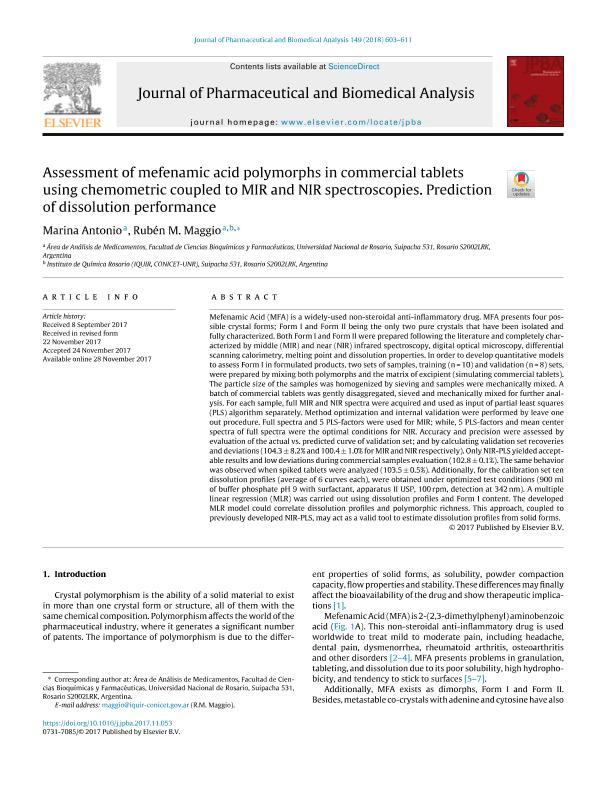Artículo
Assessment of mefenamic acid polymorphs in commercial tablets using chemometric coupled to MIR and NIR spectroscopies. Prediction of dissolution performance
Fecha de publicación:
02/2018
Editorial:
Elsevier Science
Revista:
Journal of Pharmaceutical and Biomedical Analysis
ISSN:
0731-7085
Idioma:
Inglés
Tipo de recurso:
Artículo publicado
Clasificación temática:
Resumen
Mefenamic Acid (MFA) is a widely-used non-steroidal anti-inflammatory drug. MFA presents four possible crystal forms; Form I and Form II being the only two pure crystals that have been isolated and fully characterized. Both Form I and Form II were prepared following the literature and completely characterized by middle (MIR) and near (NIR) infrared spectroscopy, digital optical microscopy, differential scanning calorimetry, melting point and dissolution properties. In order to develop quantitative models to assess Form I in formulated products, two sets of samples, training (n = 10) and validation (n = 8) sets, were prepared by mixing both polymorphs and the matrix of excipient (simulating commercial tablets). The particle size of the samples was homogenized by sieving and samples were mechanically mixed. A batch of commercial tablets was gently disaggregated, sieved and mechanically mixed for further analysis. For each sample, full MIR and NIR spectra were acquired and used as input of partial least squares (PLS) algorithm separately. Method optimization and internal validation were performed by leave one out procedure. Full spectra and 5 PLS-factors were used for MIR; while, 5 PLS-factors and mean center spectra of full spectra were the optimal conditions for NIR. Accuracy and precision were assessed by evaluation of the actual vs. predicted curve of validation set; and by calculating validation set recoveries and deviations (104.3 ± 8.2% and 100.4 ± 1.0% for MIR and NIR respectively). Only NIR-PLS yielded acceptable results and low deviations during commercial samples evaluation (102.8 ± 0.1%). The same behavior was observed when spiked tablets were analyzed (103.5 ± 0.5%). Additionally, for the calibration set ten dissolution profiles (average of 6 curves each), were obtained under optimized test conditions (900 ml of buffer phosphate pH 9 with surfactant, apparatus II USP, 100 rpm, detection at 342 nm). A multiple linear regression (MLR) was carried out using dissolution profiles and Form I content. The developed MLR model could correlate dissolution profiles and polymorphic richness. This approach, coupled to previously developed NIR-PLS, may act as a valid tool to estimate dissolution profiles from solid forms.
Palabras clave:
Polymorphism
,
Mefenamic Acid
,
MIR NIR
,
Chemometrics
Archivos asociados
Licencia
Identificadores
Colecciones
Articulos(IQUIR)
Articulos de INST.DE QUIMICA ROSARIO
Articulos de INST.DE QUIMICA ROSARIO
Citación
Antonio, Marina; Maggio, Ruben Mariano; Assessment of mefenamic acid polymorphs in commercial tablets using chemometric coupled to MIR and NIR spectroscopies. Prediction of dissolution performance; Elsevier Science; Journal of Pharmaceutical and Biomedical Analysis; 149; 2-2018; 603-611
Compartir
Altmétricas




